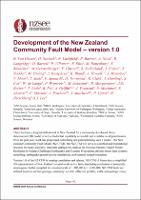Development of the New Zealand Community Fault Model – version 1.0

Download
Date
2021-04-14Authors
Van Dissen, Russ
Seebeck, Hannu
Litchfield, Nicola
Barnes, Philip
Nicol, Andy
Langridge, Robert
Barrell, David
Villamor, Pilar
Ellis, Susan
Rattenbury, Mark
Bannister, Stephen
Gerstenberger, Matt
Ghisetti, Francesca
Sutherland, Rupert
Fraser, Jeff
Nodder, Scott
Stirling, Mark
Humphrey, Jade
Bland, Kyle
Howell, Andrew
Mountjoy, Joshu
Moon, Vicki
Stahl, Tim
Spinardi, Francesca
Townsend, Dougal
Clark, Kate
Hamling, Ian
Cox, Simon
de Lange, William
Wopereis, Paul
Johnston, Mike
Morgenstern, Regine
Eccles, Jennifer
Little, Tim
Fry, Bill
Griffin, Jonathan
Townsend, John
Mortimer, Nick
Alcaraz, Samantha
Massiot, Cecile
Rowland, Julie
Muirhead, James
Upton, Phaedra
Hirschberg, Hamish
Lee, Julie
Metadata
Show full item recordAbstract
There has been a long-identified need in New Zealand for a community-developed three-dimensional fault model that is accessible and available to all. Over the past year, work has progressed on building and parameterising such a model – the New Zealand Community Fault Model (NZ CFM). The NZ CFM will serve as a unified and foundational resource for many societally important applications such as the National Seismic Hazard model, Resilience to Natures Challenges Earthquake and Tsunami Programme (synthetic earthquakes project), physics-based fault systems modelling, earthquake ground-motion simulations, and tsunami hazard evaluation.
Version 1.0 of the NZ CFM is nearing finalisation and release. NZ CFM v1.0 provides a simplified 3D representation of New Zealand’s crustal-scale active faults (including a selection of potentially seismogenic faults) compiled at a nominally scale of 1:500,000 to 1:1,000,000. NZ CFM faults are defined based on surface traces, seismicity, seismic reflection profiles, wells, and geologic cross sections following methodologies developed by the Southern California Earthquake Center. The model presently incorporates more than 800 objects (i.e., faults), which include triangulated surface representations of those faults linked to parameters such as dip and dip direction, seismogenic rupture depth, sense of movement, slip direction, and net slip rate.
Here we present an overview of NZ CFM v1.0 including the formulation, parameterisation and documentation of that model in 3D; and the availability of that model in a readily accessible form(s) to support and facilitate multiple realisations and varied applications.
More information about this project can be found at: https://www.gns.cri.nz/nzcfm
